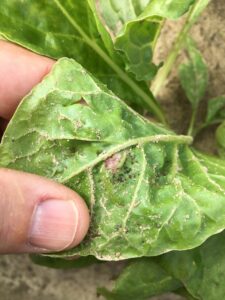Sweet Corn
Fall armyworm (FAW) infestations in whorl stage plantings in northern and central counties have dropped to very low levels. This may not be the case in southern counties. Growers are advised to check whorl and seedling stage corn plantings weekly for signs of FAW. Consider treating if infestation rates exceed 10%. This pest is capable of significant injury to sweet corn plants, resulting in severe stunting and failure to produce viable ears. Note that growers of Attribute II type genetically engineered corn are unlikely to see damage from FAW.
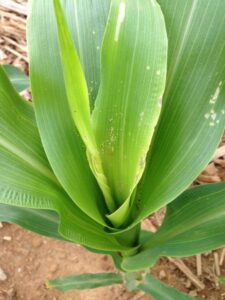
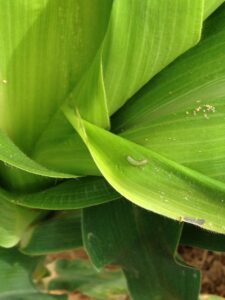 Newly hatched FAW larvae cause holes and scratches on leaves that are similar to European corn borer (ECB) feeding, except that they tend to be more concentrated and always lead down into the whorl (see photos at left). As the larvae grow, the feeding becomes more destructive, with large ragged holes and obvious droppings deposited in the whorl (see photo at right).
Newly hatched FAW larvae cause holes and scratches on leaves that are similar to European corn borer (ECB) feeding, except that they tend to be more concentrated and always lead down into the whorl (see photos at left). As the larvae grow, the feeding becomes more destructive, with large ragged holes and obvious droppings deposited in the whorl (see photo at right). 
We will provide updates on new FAW appearances and severity as reports come in. FAW are resistant to synthetic pyrethroids. Effective sprays should include IRAC grp. 5 (spinosyns) or IRAC grp. 28 (diamides). The carbamate (IRAC grp. 1A) Lannate is also still effective. Sufficient water should be used in the applications to allow the solution to penetrate the layer of droppings that may have formed above the caterpillar.
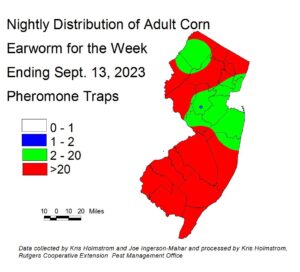 Northern and central blacklight traps and all pheromone traps have continued to catch corn earworm (CEW) moths at a consistent rate over the past week, and today’s map is largely unchanged from last week. Pheromone trap information is available from all northern and central sites, with now very limited input from southern New Jersey (see map at lower right, with individual reporting sites). We will use a combination of pheromone and blacklight trap types to derive silk spray schedules by region. We are now only able to check many traps on a weekly basis, as our student help has returned to their studies. This can give some areas an artificially high or low appearance of activity. Nonetheless, very high pheromone trap catches continue into Morris County. Red areas on the pheromone trap map (at upper right) indicate a 3-day spray schedule. Although the green areas indicate a 4 day schedule, blacklight trap catches in those areas are consistent with a 3-day schedule. This is reflected in the suggested spray schedules below. Cooler evening temperatures forecast for later this week may suppress activity temporarily. Silking corn is at extreme risk of CEW infestation at this time. Be sure to access information from this publication in the upcoming weeks to determine how frequently you should treat silking sweet corn to protect it from CEW infestation.
Northern and central blacklight traps and all pheromone traps have continued to catch corn earworm (CEW) moths at a consistent rate over the past week, and today’s map is largely unchanged from last week. Pheromone trap information is available from all northern and central sites, with now very limited input from southern New Jersey (see map at lower right, with individual reporting sites). We will use a combination of pheromone and blacklight trap types to derive silk spray schedules by region. We are now only able to check many traps on a weekly basis, as our student help has returned to their studies. This can give some areas an artificially high or low appearance of activity. Nonetheless, very high pheromone trap catches continue into Morris County. Red areas on the pheromone trap map (at upper right) indicate a 3-day spray schedule. Although the green areas indicate a 4 day schedule, blacklight trap catches in those areas are consistent with a 3-day schedule. This is reflected in the suggested spray schedules below. Cooler evening temperatures forecast for later this week may suppress activity temporarily. Silking corn is at extreme risk of CEW infestation at this time. Be sure to access information from this publication in the upcoming weeks to determine how frequently you should treat silking sweet corn to protect it from CEW infestation.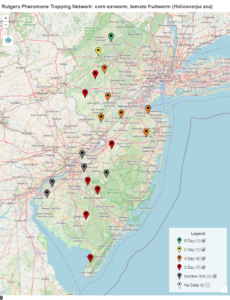
The highest nightly blacklight trap catches of CEW for the week ending 9/13/23 are as follows:
| Princeton 11 | Milltown 4 | Chester 3 |
| Georgetown 10 | New Egypt 4 | South Branch 3 |
| Hillsborough 6 | Allentown 3 | Morristown 2 |
| Bellemeade 5 | Califon 3 | Dayton 2 |
The highest nightly pheromone trap catches of CEW for the week ending 9/13/23 are as follows:
| Snyder Farm (Hunterdon) 77 | Georgetown 43 | Matawan 17 |
| East Vineland 50 | Green Creek 35 | Pennington 13 |
| Berlin 49 | Chester 31 | Dayton 11 |
| Califon 45 | Elm 24 | Farmingdale 8 |
Silking Spray Schedules*:
South – 3 days
Central – 3 days
North – 3 days
*These recommendations are based on regional catches. Adhere to tighter spray schedules if indicated by local trap catches. Synthetic pyrethroids alone should NOT be used for corn earworm (CEW) protection on silking corn, or for fall armyworm (FAW) management at any stage. Control with these materials is very inconsistent.
Pumpkins and Winter Squash
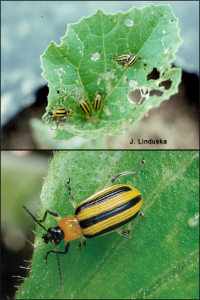 With maturing fruit present, growers should check at least weekly for the presence of striped cucumber beetles (photo at right). This pest, which is important early in the life of the plants, again becomes economically significant with maturing fruit, as it can scar the rinds of pumpkins and other squashes. If cucumber beetles are found at more than 2 sites in a 10 site sample, and any fruit injury is detected, an insecticide application to prevent further injury may be warranted. For useful materials, see the Pumpkin and Winter Squash section of the 2022-23 Commercial Guide. Populations of melon aphids are beginning to appear in some pumpkin and winter squash fields (see photo below at left). This pest has the ability to increase to extremely high population levels in fields. When this happens, their sticky droppings are deposited on fruit below the canopy. Sooty
With maturing fruit present, growers should check at least weekly for the presence of striped cucumber beetles (photo at right). This pest, which is important early in the life of the plants, again becomes economically significant with maturing fruit, as it can scar the rinds of pumpkins and other squashes. If cucumber beetles are found at more than 2 sites in a 10 site sample, and any fruit injury is detected, an insecticide application to prevent further injury may be warranted. For useful materials, see the Pumpkin and Winter Squash section of the 2022-23 Commercial Guide. Populations of melon aphids are beginning to appear in some pumpkin and winter squash fields (see photo below at left). This pest has the ability to increase to extremely high population levels in fields. When this happens, their sticky droppings are deposited on fruit below the canopy. Sooty 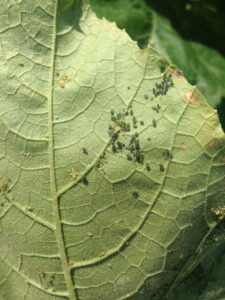 mold fungus grows on this sticky coating, disfiguring fruit. Additionally, hornets are attracted to the aphid droppings; creating a potential issue in U-pick situations. Check fields weekly for the presence of melon aphid colonies developing on the undersides of leaves. If aphids are found in more than one sample site/10 sites, consider an insecticide application to limit population spread. There are a number of effective materials listed in the Pumpkin and Winter Squash section of the 2022-23 Commercial Guide. Avoid pyrethroid insecticides for aphids or other insect pests, as these can cause aphids to increase. Prompt removal of mature fruit is often the best way to prevent losses due to soil disease, insects and deer/rodents.
mold fungus grows on this sticky coating, disfiguring fruit. Additionally, hornets are attracted to the aphid droppings; creating a potential issue in U-pick situations. Check fields weekly for the presence of melon aphid colonies developing on the undersides of leaves. If aphids are found in more than one sample site/10 sites, consider an insecticide application to limit population spread. There are a number of effective materials listed in the Pumpkin and Winter Squash section of the 2022-23 Commercial Guide. Avoid pyrethroid insecticides for aphids or other insect pests, as these can cause aphids to increase. Prompt removal of mature fruit is often the best way to prevent losses due to soil disease, insects and deer/rodents.
Cole Crops
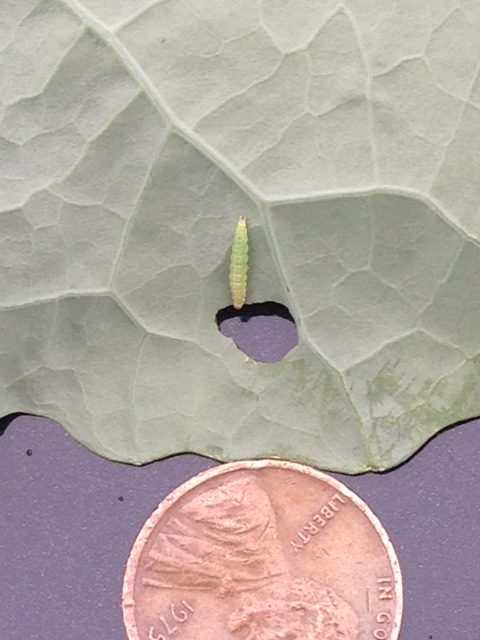 With fall plantings now underway, it is typical for diamondback moth larvae ((DBM) see photo at right) to become the dominant caterpillar pest in many cole crop fields. This pest can multiply quickly, with a generation completed in under 2 weeks with high temperatures. Furthermore, this pest is not responding to chlorantraniliprole (Coragen) in many parts of the state. Effective materials continue to be IRAC 5 materials (spinosyns), and the IRAC 6 material, ememectin benzoate (Proclaim). Consultants and scouts report good efficacy with the IRAC 21A, tolfenpyrad (Torac) . Be sure to check the Cole Crops Section of the 2022-23 Commercial Guide for specifics, as PHI’s and crop labels vary. It is important to return to treated fields within 2-3 days to assess the efficacy of the insecticide applications. Effective materials should eliminate DBM larvae within 48 hours.
With fall plantings now underway, it is typical for diamondback moth larvae ((DBM) see photo at right) to become the dominant caterpillar pest in many cole crop fields. This pest can multiply quickly, with a generation completed in under 2 weeks with high temperatures. Furthermore, this pest is not responding to chlorantraniliprole (Coragen) in many parts of the state. Effective materials continue to be IRAC 5 materials (spinosyns), and the IRAC 6 material, ememectin benzoate (Proclaim). Consultants and scouts report good efficacy with the IRAC 21A, tolfenpyrad (Torac) . Be sure to check the Cole Crops Section of the 2022-23 Commercial Guide for specifics, as PHI’s and crop labels vary. It is important to return to treated fields within 2-3 days to assess the efficacy of the insecticide applications. Effective materials should eliminate DBM larvae within 48 hours.
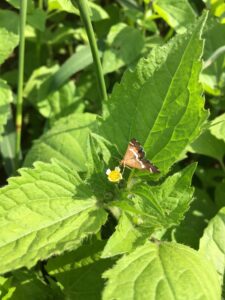 Recent farm visits in Somerset County have revealed high numbers of Hawaiian beet webworm (HBWW) moths in weedy areas (photo at left). Galinsoga patches seem to be favored by the moths. While no injury to host crops (beet greens, swiss chard, spinach) have been reported, the presence of adults constitutes a threat to these crops. Growers in all counties would be wise to check plantings of these hosts at least weekly for the presence of foliar injury. Numerous holes in leaves, with larvae on the lower leaf surfaces (photo at right). Recommended insecticides may be found in the Spinach Section of the 2022-23 Commercial Guide.
Recent farm visits in Somerset County have revealed high numbers of Hawaiian beet webworm (HBWW) moths in weedy areas (photo at left). Galinsoga patches seem to be favored by the moths. While no injury to host crops (beet greens, swiss chard, spinach) have been reported, the presence of adults constitutes a threat to these crops. Growers in all counties would be wise to check plantings of these hosts at least weekly for the presence of foliar injury. Numerous holes in leaves, with larvae on the lower leaf surfaces (photo at right). Recommended insecticides may be found in the Spinach Section of the 2022-23 Commercial Guide.
